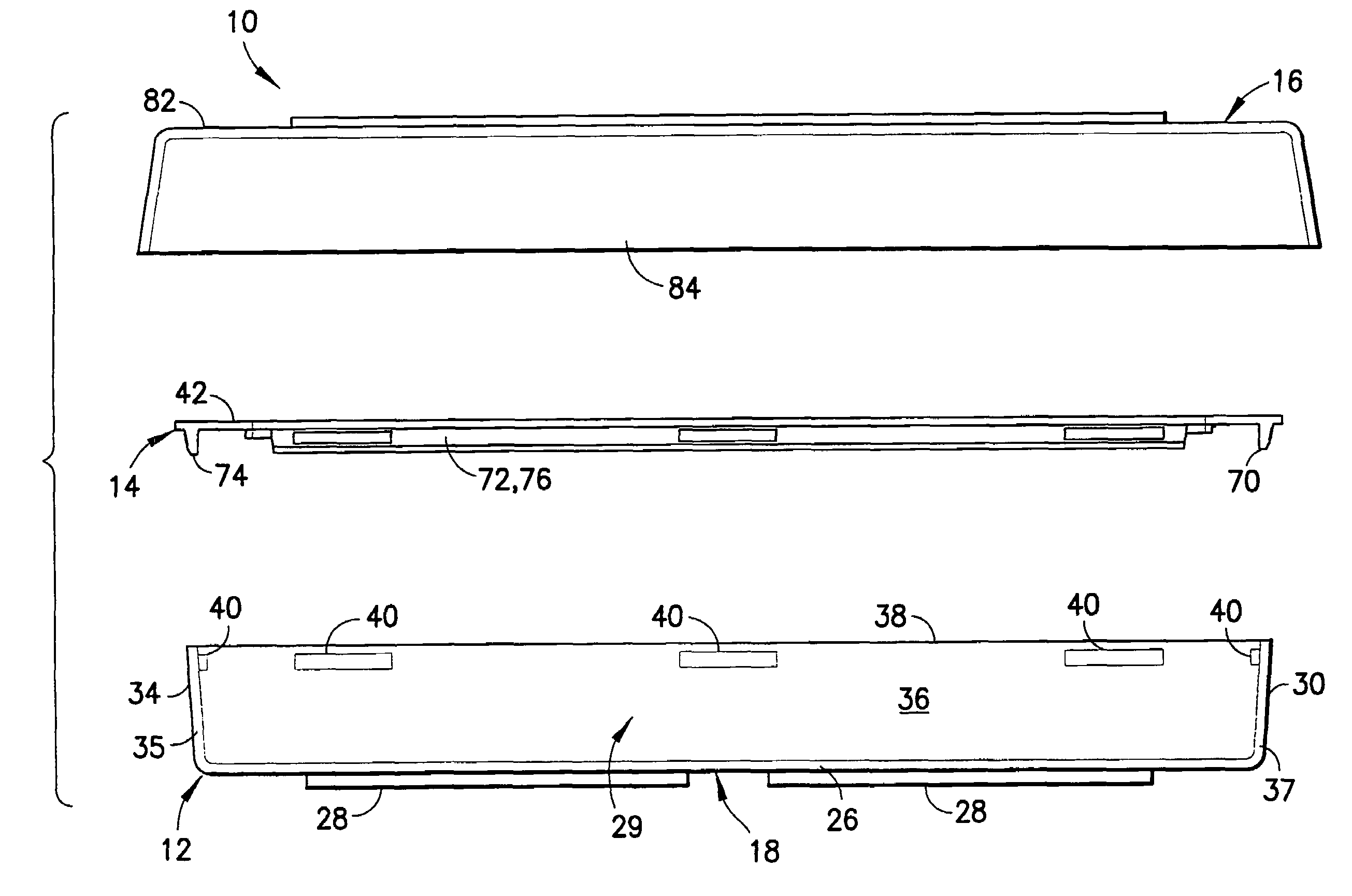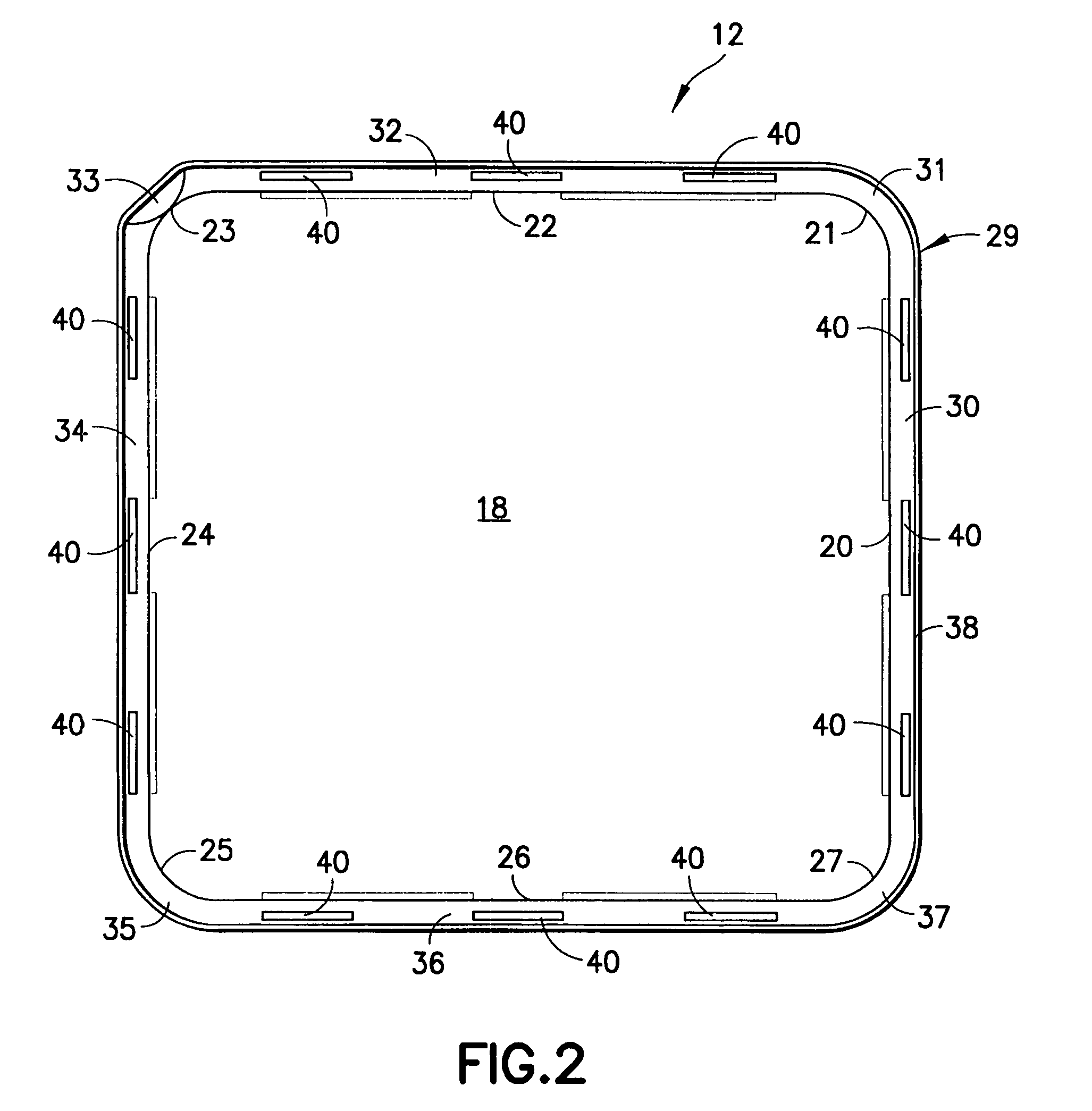Fluid containment for laboratory containers
a technology for laboratory containers and liquid media, applied in the field of culture plates or dishes, can solve the problems of reducing the volume of liquid media and biological materials, affecting the filtration separation of biological materials, and exceeding the height of the side wall, so as to achieve efficient stacking of culture dish assemblies
- Summary
- Abstract
- Description
- Claims
- Application Information
AI Technical Summary
Benefits of technology
Problems solved by technology
Method used
Image
Examples
second embodiment
[0055]a splash guard in accordance with the subject invention is identified generally by the numeral 114 in FIG. 8. Splash guard 114 is very similar to splash guard 14 described above and illustrated most clearly in FIGS. 3 and 4. Elements of splash guard 114 that are identical to splash guard 14 merely are identified by the same reference numerals herein, and a repeated description is not provided. Splash guard 114 differs from splash guard 14 in two significant respects. In particular, splash guard 114 includes a top wall 142 with an outer periphery 144. Outer periphery 144 has substantially straight outer side edges 150, 152, 154 and 156 and arcuate corners 151, 153, 155 and 157 as shown in FIG. 8. Substantially straight edges 150, 152, 154, and 156 are dimensioned and configured to substantially register with the outer periphery of top edge 38 of side wall enclosure 29 on culture dish 12. However, substantially straight edges 150, 152, 154 and 156 are characterized further by li...
third embodiment
[0057]FIGS. 12-15 show a culture dish assembly 210 in accordance with the subject invention. The culture dish assembly 210 includes a rectangular culture dish 212 that is very similar to culture dish 12 described and illustrated above. More particularly, culture dish 212 includes a bottom wall 218 and a side wall enclosure 229. However, side wall enclosure 229 of culture dish 212 does not include elongate projections comparable to elongate projections 40 on culture dish 12. Rather, interior surfaces of side wall enclosure 229 may be substantially smooth between top edge 238 of side wall enclosure 229 and bottom wall 218. Importantly, however, side wall enclosure 229 flares outwardly from bottom wall 218 to facilitate molding.
[0058]Culture dish assembly 210 further includes a splash guard 214 with a frame-shaped wall 242. Frame-shaped wall 242 includes an outer periphery 244 dimensioned to nest partly within side wall enclosure 229 of culture dish 212. Thus, outer periphery 244 of fr...
fourth embodiment
[0060]a culture dish assembly in accordance with the subject invention is identified by the numeral 310 in FIG. 16. Culture dish assembly 310 includes a culture dish 312 that is substantially identical to culture dish 212 described above and illustrated in FIGS. 12 and 13. Culture dish assembly 310 further includes a splash guard 314 with a frame-shaped generally planar wall 342. Frame-shaped wall 342 has an outer periphery 344 and an inner periphery 346. Outer periphery 344 is dimensionally comparable to outer periphery 244 of splash guard 214 described above and illustrated in FIGS. 12-15. Inner periphery 346, however, is provided with a plurality of finger slots 350 that are dimensioned to be engaged by fingers or by laboratory equipment for pulling splash guard 314 out of culture dish 312.
PUM
| Property | Measurement | Unit |
|---|---|---|
| Distance | aaaaa | aaaaa |
Abstract
Description
Claims
Application Information
 Login to View More
Login to View More - R&D
- Intellectual Property
- Life Sciences
- Materials
- Tech Scout
- Unparalleled Data Quality
- Higher Quality Content
- 60% Fewer Hallucinations
Browse by: Latest US Patents, China's latest patents, Technical Efficacy Thesaurus, Application Domain, Technology Topic, Popular Technical Reports.
© 2025 PatSnap. All rights reserved.Legal|Privacy policy|Modern Slavery Act Transparency Statement|Sitemap|About US| Contact US: help@patsnap.com



